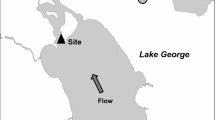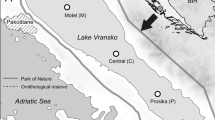Abstract
We studied the effect of water level changes in Lake Võrtsjärv (270 km2, mean depth 2.8 m) on the abundance and composition of phytoplankton based on a 35-year database. Analysis of long time-series (since 1884) revealed a strong influence of the North Atlantic Oscillation on the water level in this lake. The registered maximum range of water level in L. Võrtsjärv is 3.2 m, which corresponds to 1.4 times difference in the lake area, 2.5 times difference in the mean depth and 3.5 times difference in volume. Cyanobacteria build up 2/3 of the average phytoplankton biomass during the ice-free period (May–October). On average 75% of the cyanophyte biomass is formed by four filamentous species. Centric diatoms from the genera Aulacoseira and Cyclotella dominate in the biomass of diatoms. Phytoplankton biomass was significantly lower in years of high water level and the changes were unrelated to nutrient loading. The share of filamentous blue-greens among phytoplankton followed the changes in the water level while there was a succession of dominants. Planktolyngbya limnetica reached its maximum in the low water period in the middle of the 1970s. Limnothrix redekei and L. planktonica started to dominate in the high water period in the 1980s while the total biomass decreased substantially in spite of high nutrient loading. During the low water period in the 1990s, the role of the nitrogen-fixing species Aphanizomenon skujae increased. The succession was caused by changes in light and nutrient availability in the fully mixed environment. As low light species, filamentous Limnothrix spp. were most successful in competition for light and phosphorus in deeper water while A. skujae was favoured by high light intensities and a low N/P ratio in shallow water.
Similar content being viewed by others
References
Coops, H., M. Beklioglu & T. L. Crisman, 2003. The role of water-level fluchiations in shallow lake ecosystems – workshop conclusions. Hydrobiologia 506–509: 23–27.
Edler, L. (ed.), 1979. Recommendations forMarine Biological Studies in the Baltic Sea. Phytoplankton and Chlorophyll: The Baltic Marine Biologists. Publications No. 5: 38 pp.
Foy, R. H. & C. E. Gibson, 1982. Photosynthetic characteristics of planktonic blue-green algae: changes in photosynthetic capacity and pigmentation of Oscillatoria redekei van Goor under high and low light. Br. Phycol. J. 17: 183–193.
George, D. G., J. F. Talling & E. Rigg, 2000. Factors influencing the temporal coherence of five lakes in the English Lake District. Freshwat. Biol. 43: 449–461.
Gibson, C. E., 1993. The phytoplankton populations in Lough Neagh. In Wood, R. B. & R. V. Smith (eds), Lough Neagh. Kluwer Academic Publishers, Dordrecht, Boston, London: 203– 223.
Hurrell, J. W., 1995. Decadal Trends in the North Atlantic Oscillation: Regional Temperatures and Precipitation. Science 269: 676–679.
Hurrell, J. W., Y. Kushnir & M. Visbeck, 2001. The North Atlantic Oscillation. Science 291: 603–605.
Irigoien, X., R. P. Harris, R. N. Head & D. Harbour, 2000. North Atlantic Oscillation and spring bloom phytoplankton composition in the Englisch Channel. J. Plankton Res. 22: 2367–2371.
Jaani, A., 1990. The water regime and water balance of Lake Võrtsjärv. Eesti Loodus 11: 743–747.
Järvet, A., 1999. Ice regime of Lake Võrtsjärv and its longterm changes. Publicationes Instituti Geographici Universitatis Tartuensis 85: 171–179.
Järvet, A., 2001. Long-term changes of nutrient runoff in Lake Võrtsjärv catchment area. In Seepõld, M. (ed.), Environmental Impact andWater Management in a Catchment Area Perspective. Tallinn Technical University, Tallinn: 54–62.
Kukk, E., 1958. Sinivetikate liikide ja vormide uusleide NSV Liidus. TRÑ Toim. Botaanika-alased tööd 64, 1: 198–209.
Magnuson, J. J., K. E. Webster, R. A. Assel, C. J. Bowser, P. J. Dillon, J. D. Eaton, H. E Evans, E. J. Fee, R. I. Hall, L. R. Mortsch, D. W. Schindler & F. H. Quinn, 1997. Potential effacts of climate changes on aquatic ecosystems: Laurentian Great Lakes and Precambrian Shield Region. In Cushing, C. E. (ed.), Freshwater Ecosystems and Climate Change in North America. A Regional Assessment. John Wiley & Sons: 7–53.
Meffert, M.-E., 1989. In situ and in vitro photosynthesis of Limnothrix redekei (Cyanophyta). Arch. Hydrobiol. 116: 401–414.
Mühlen, M. von zur & G. Schneider, 1920. Der See Wirzjerw in Livland. Archiv für die Naturkunde des Ostbaltikums 14, 1: 1– 156.
Nõges, P., T. Feldmann, J. Haberman, A. Järvalt, A. Kangur, K. Kangur, H. Timm, T. Timm, A. Tuvikene & P. Zingel, 2001. Deviation of Lake Võrtsjärv from its pristine status documented 90 years ago. Proceedings of 9th Int. Conf. Cons. Manag. Lakes. Session 5: 221–224.
Nõges, T. & P. Nõges, 1999. The effect of extreme water level decrease on hydrochemistry and phytoplankton in a shallow eutrophic lake. Hydrobiologia 409: 277–283.
Nõges, T. & I. Solovjova, 2000. The influence of different solvents and extraction regimes on the recovery of chlorophyll a from freshwater phytoplankton. Geophysica 36: 161–168.
Ott, I., P. Nõges, R. Laugaste & T. Kõiv, 2002. Occurrence of Limnothrix redekei in Estonian lakes. Arch. Hydrobiol. Algological Studies (in press).
Padisák, J. & C. S. Reynolds, 2003. Shallow lakes: The absolute, the relative, the functional and the praguratic. Hydrobiologia 506– 509: 1–11.
Paeth, H., A. Hense, R. Glowienka-Hense, R. Voss & U. Cubasch, 1999. The North Atlantic Oscillation as an indicator for greenhouse-gas induced regional climate change. Climate Dynamics 15: 953–960.
Riley, G. A., 1957. Phytoplankton of the North Central Sargasso Sea. Limnology and Oceanography 2: 252–270.
Pork, M. & V. Kõvask, 1973. Vetikad. In Timm, T. (ed.), Võrtsjärv. Valgus, Tallinn: 95–99.
Scheffer, M., 1998. Ecology of Shallow Lakes. Chapman and Hall, London.
Tomingas, O. & J. Jaagus, 1999. Large-scale fluctuations of atmospheric circulation and their influence on climatic variation in Estonia. Publicationes Instituti Geographici Universitatis Tartuensis 85: 106–121.
Utermöhl, H., 1958. Zur Vervollkommnung der quantitatieven Phytoplankton-Methodik. Mitteil. int. Ver. theor. angew. Limnol. 9: 1–38.
Author information
Authors and Affiliations
Rights and permissions
About this article
Cite this article
Nõges, T., Nõges, P. & Laugaste, R. Water level as the mediator between climate change and phytoplankton composition in a large shallow temperate lake. Hydrobiologia 506, 257–263 (2003). https://doi.org/10.1023/B:HYDR.0000008540.06592.48
Issue Date:
DOI: https://doi.org/10.1023/B:HYDR.0000008540.06592.48




